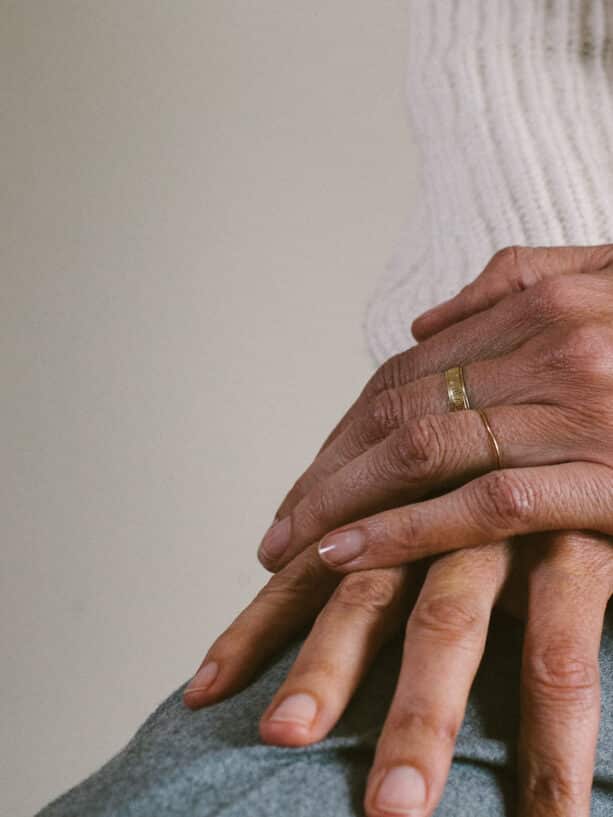TL;DR –When collective trauma like contested elections triggers your nervous system, you're not being "too sensitive"—you're experiencing a biologically normal response that's even more intense if you carry relational trauma from childhood. Your body's reactions—the anxiety in your stomach, exhaustion, compulsive news-checking—reflect sophisticated survival mechanisms responding to genuine threat, especially for marginalized communities whose bodies hold generations of historical trauma encoded in their DNA through epigenetic changes. Research shows that trauma literally alters gene expression in ways that can be inherited, explaining why political upheaval can feel so viscerally personal and why certain communities experience heightened physiological responses to political threats.
The path forward isn't about calming down or managing stress through individual coping alone—it's about understanding that our nervous systems are designed for co-regulation and collective healing. Through practices like grounding techniques, bilateral movement, and intentional community connection, you can work with your body's natural capacity for regulation while honoring the legitimate wisdom of your threat-detection system. Building resilience means expanding your window of tolerance through consistent engagement with both your individual responses and collective support systems, recognizing that healing trauma—like experiencing it—happens in relationship with others.
Let me just name the elephant in the room: The results of this election were devastating.
As a trauma therapist who spends her days working with folks healing from complex relational trauma, this week I found myself sitting with client after client, all of them experiencing the same thing in their bodies: the hot heat of anxiety in our stomachs, lead limbs, the fog of overwhelm descending like a heavy blanket. Collective trauma.
And between sessions? I felt it too — bone-deep exhaustion, a pit in my stomach, and a scattered feeling in my mind that no amount of Athletic Greens or Kava drops in my water could touch.
The Biology of Collective Response
Look, when we talk about collective trauma – and yes, events like contested elections absolutely create collective trauma – we need to understand something profound happening at multiple levels: in our bodies, in our genes, and across generations.
Recent epigenetic research reveals something remarkable: trauma doesn’t just live in our memories or manifest in our symptoms. Trauma literally changes how our genes express themselves, creating biological alterations that parents can pass down. When researchers studied children of trauma survivors, they identified specific epigenetic markers—particularly in genes regulating stress response—that their parents’ experiences had modified before conception.
Those physical sensations you’re experiencing? The difficulty sleeping through the night? The compulsive news-checking and IG scrolling? The feeling of being simultaneously shut down and ramped up? These aren’t signs of weakness or failure. They’re evidence of an exquisitely tuned nervous system doing exactly what it evolved to do in the face of threat.
When Personal History Meets Political Present
If you have a history of relational trauma—if you grew up in an environment where safety felt conditional, power shifted unpredictably, and others often invalidated your voice or experience—your responses may feel especially intense right now. Your nervous system draws on its hard-earned wisdom to detect threats, even when you’re no longer in danger.
As preeminent trauma clinician Bessel van der Kolk, MD, writes, “The body keeps the score.” But what’s fascinating is how deeply this scoring goes. Social baseline theory suggests something profound: our nervous systems aren’t designed to regulate in isolation. We’re wired for co-regulation, for sensing and responding to collective threat. And this explains why political trauma can feel so viscerally personal. Our bodies recognize threats to the collective as threats to survival itself.
Let me share some data that might help normalize what you’re experiencing: According to the American Psychological Association’s 2024 Stress in America survey, 69% of Americans report significant physiological stress around elections. For marginalized communities who have historically faced systemic oppression and violence, those numbers climb even higher. This isn’t just about statistics—it’s about survival circuits lighting up in response to genuine threat.
Curious if you come from a relational trauma background?
Take this 5-minute, 25-question quiz to find out — and learn what to do next if you do.
START THE QUIZBut here’s where it gets even more complex and profound: your body isn’t just responding to current events or even your personal history. It’s responding to something much older and deeper. Historical trauma isn’t just metaphorical—it’s literally written into our DNA. Research shows that trauma can create epigenetic changes that alter how our genes express themselves, changes that can be inherited across generations.
The Inheritance of Trauma
This helps explain why certain communities experience heightened physiological responses to political threats. What we’re seeing isn’t “oversensitivity”—it’s the profound wisdom of generations speaking through our cells. Our bodies remember what our minds might want to forget:
For Black Americans, the chronic stress of navigating systemic racism creates what researchers call “racial battle fatigue.” This isn’t just a metaphor—studies show measurable changes in stress hormones, immune function, and cardiovascular responses that mirror those seen in chronic trauma exposure. The body literally carries the weight of historical and ongoing oppression.
For Indigenous communities, political upheaval often reactivates centuries of displacement, genocide, and cultural erasure. Research on intergenerational trauma in Indigenous populations reveals specific alterations in stress-response genes that can be traced back through generations. These aren’t just historical events—they’re present realities held in the bodies of people today.
For LGBTQ+ individuals, election cycles often carry the weight of existential threat. Rights and protections that feel newly secured can be stripped away with the stroke of a pen, leaving bodies braced for harm and loss. Studies show that minorities under political threat experience measurable changes in their nervous system’s baseline functioning—a perpetual state of physiological vigilance.
As trauma researcher Resmaa Menakem writes in My Grandmother’s Hands, “Trauma affects not just individuals, but the ecosystems in which they live.” This isn’t poetic language—it’s biological reality. Our nervous systems exist in a complex web of connection, what neuroscientists call “social baseline theory.” We’re quite literally wired to sense and respond to threats to our collective well-being.
Understanding Our Collective Nervous System
Understanding this biology of collective trauma changes how we think about healing. It’s not just about “managing stress” or “staying informed while maintaining boundaries”—though these matter.
It’s about recognizing that our bodies are engaging in a profound act of survival and resistance.
When your nervous system floods with anxiety during a news cycle, it’s not malfunctioning. It’s performing exactly as designed, alerting you to threats to your survival and the survival of your community. The challenge isn’t to override these responses but to learn to work with them, to honor their wisdom while building our capacity to hold collective pain.
Recent research in interpersonal neurobiology shows us something fascinating: while trauma can be collectively transmitted, so can resilience. When we gather in communities of support, when we move together, when we share our stories and our strategies for survival, we’re not just coping—we’re actively reshaping our nervous systems and potentially even our genetic expression.
This is why, in times of political trauma, isolation can feel particularly devastating. Our bodies are literally designed to co-regulate, to find safety and stability in connection with others. The same mechanisms that make us vulnerable to collective trauma also make us capable of collective healing.
Working with Body Wisdom
Here’s what the research—and my clinical experience—tells us about working with these profound bodily responses to collective trauma:
First, we need to understand that regulation isn’t about calming down—it’s about building capacity to hold intensity. Studies in neuroplasticity show that our nervous systems can expand their “window of tolerance” through consistent, mindful engagement with our physiological responses.
This might look like:
- Noticing and naming the sensations in your body without trying to change them. Research shows that simply labeling our physiological experiences can help regulate the amygdala’s threat response.
- Engaging in rhythmic, bilateral movement—walking, drumming, dancing. These activities help process trauma responses through the body while activating the brain’s inherent capacity for integration.
- Finding ways to safely experience collective emotion. Whether through protest, ritual, or gathering in community, allowing ourselves to feel with others can help move trauma through our systems rather than getting stuck in individual bodies.
These aren’t just self-help techniques. They’re biologically-based strategies for working with our nervous systems’ natural capabilities for healing and integration.
Practical Applications for Different Nervous States
When we’re navigating collective trauma responses, we need different tools for different states of nervous system activation. This isn’t about following a one-size-fits-all protocol—it’s about learning to read and respond to our body’s changing needs.
For states of hyperarousal—when anxiety peaks and the sympathetic nervous system floods our bodies with survival energy:
- Ground through weight and gravity, feeling the solid support beneath you.
- Engage the vagal brake through extended exhales, making them longer than your inhales. As outlined in Polyvagal Theory by Stephen Porges, extended exhalations activate the parasympathetic nervous system, helping to regulate heightened states of arousal.
- Use bilateral stimulation, such as walking or tapping, to process emotional distress. This practice leverages the brain’s inherent capacity for integration, as noted in trauma-processing research.
- Orient to your surroundings by letting your eyes track the environment for signs of safety. This simple action signals the nervous system that the immediate environment is secure, reducing activation, according to research on nervous system regulation.
For states of hypoarousal—when we collapse into numbness or dissociation:
- Begin with subtle movement, like wiggling fingers or toes, to gently reconnect with bodily sensations.
- Use sound, such as humming or gentle vocalizations, to activate the vagus nerve and restore a sense of connection. Studies on the vagus nerve, as explored in the Polyvagal Institute, demonstrate how sound-based interventions engage the social engagement system.
- Seek sensory input, like holding a textured object or noticing temperature changes, to draw awareness back into the body.
- Connect with another regulated nervous system when possible. As described in nervous system co-regulation research, interpersonal connection plays a critical role in fostering resilience and recovery.
Building Resilience Through Intentional Practices
Understanding trauma through this neurobiological lens offers both validation and direction. We can’t think our way out of trauma responses, but we can work with our body’s innate capacity for regulation and healing.
This isn’t about “getting over it” or “staying professional” in the face of genuine threat. It’s about building sustainable practices that honor both our sensitivity and our resilience, our individual needs and our collective responsibility. The question isn’t how to stop feeling deeply about what’s happening in the world—it’s how to hold that depth of feeling while continuing to function, contribute, and create change.
Some concrete practices, grounded in neuroscience and clinical experience, include:
- Create a “nervous system map.” Track when and where your system spikes or collapses. These patterns, as supported by Polyvagal Theory, reflect your body’s response to subtle and overt threats. Mapping them can help you anticipate and manage dysregulation.
- Build “regulation anchors” into your daily routine. These consistent practices remind your nervous system it can find stability even amidst uncertainty:
- Take three conscious breaths before checking the news.
- Pause to feel your feet on the ground before opening social media.
- Incorporate regular movement breaks to process activation through your body.
- Schedule intentional connection with others who understand and support your experience.
Collective Trauma Requires Collective Healing
It’s essential to recognize the communal dimensions of trauma. When you feel overwhelming anxiety, rage, or grief about political events, you’re not just processing your own emotions—you’re sensing the ripples of collective trauma moving through our shared nervous system. This contextualization doesn’t diminish your experience; it helps you see it within a broader landscape.
While individual coping strategies are vital, collective trauma ultimately requires collective healing. Research on communal trauma shows that communities engaging in shared mourning, protest, ritual, and creative expression—such as art—exhibit stronger capacities for resilience and recovery.
This is why isolation can feel especially devastating during political upheaval. Our nervous systems are designed for co-regulation—to find safety and stability in connection with others. Through these connections, we actively strengthen our collective capacity to heal.
Finding Strength in Connection and Sensitivity
We’re living in heavy times, marked by profound collective trauma and a growing understanding of how deeply this trauma moves through bodies, communities, and generations. These experiences bring challenges but also an extraordinary opportunity to care for ourselves and one another with compassion and intention.
If you’re finding it hard to “maintain normalcy” or feel like your reactions are “too much,” I want to reassure you: your sensitivity is not a flaw. It’s a signal of an attuned nervous system doing what it was designed to do—perceive, process, and respond to threats. Your struggle to function as usual during moments of upheaval is not a failure but a testament to your connection to the world around you. These responses, uncomfortable as they may feel, reflect humanity’s deep capacity for survival and care.
As Stephen Porges, creator of the polyvagal theory, explains, our nervous systems evolved not just for individual survival but for connection and collective resilience. This capacity for connection is what makes us vulnerable to collective trauma, but it is also what makes healing possible. When we allow ourselves to feel, to connect, and to move forward together, we tap into the same systems that have enabled humanity to endure and thrive through countless challenges.
Professional Support During Collective Trauma
While collective trauma requires collective healing, individual therapy can provide crucial support for processing how political events intersect with your personal trauma history. A skilled trauma therapist understands that your body’s intense responses to elections or social upheaval aren’t overreactions but intelligent survival mechanisms shaped by both personal and intergenerational experiences.
In the therapeutic space, you can explore how current political threats might be activating old relational wounds—perhaps the unpredictability echoes childhood chaos, or the powerlessness mirrors early experiences of having your voice dismissed. This work becomes especially important when collective trauma triggers personal trauma patterns, as therapy offers a regulated nervous system to co-regulate with while you build capacity to hold both individual and collective pain.
For those navigating this intersection, understanding why life feels particularly overwhelming in your thirties and forties can illuminate how life stage pressures compound with collective stressors. The therapeutic relationship provides what isolation during political upheaval strips away—a consistent, safe connection that helps your nervous system remember it can find stability even amidst uncertainty.
Wrapping up.
Our bodies hold an inherent wisdom—shaped by personal history, generational memory, and biological design. The discomfort you may be feeling—tightness in your chest, a racing mind, or bone-deep exhaustion—is not a sign of failure. It’s your body’s way of asking for something specific: rest, safety, movement, or connection. Listening to these signals, rather than overriding or suppressing them, can be deeply healing.
As Bessel van der Kolk explains in The Body Keeps the Score, trauma lives in our bodies, influencing how we respond to the world. Similarly, Peter Levine reminds us in Waking the Tiger that these responses are intelligent survival mechanisms, guiding us toward safety and regulation.
While trauma often ripples across generations, so does healing. Research from Rachel Yehuda on epigenetics demonstrates how trauma alters gene expression across generations, but also how intentional healing practices can interrupt these cycles. Every time you pause to ground yourself, every time you reach out to a friend instead of isolating, and every time you allow yourself to feel deeply without becoming overwhelmed, you’re contributing to our collective capacity for resilience.
This is the beauty of healing work: it doesn’t require perfection. It simply requires presence. The path forward isn’t about bypassing our pain but about sitting with it, learning from it, and transforming it into something meaningful. In this way, our sensitivity and connection become strengths, offering us the tools to create a world rooted in resilience, equity, and care.
Here’s to healing relational trauma and creating thriving lives on solid foundations.
Warmly,
Annie





